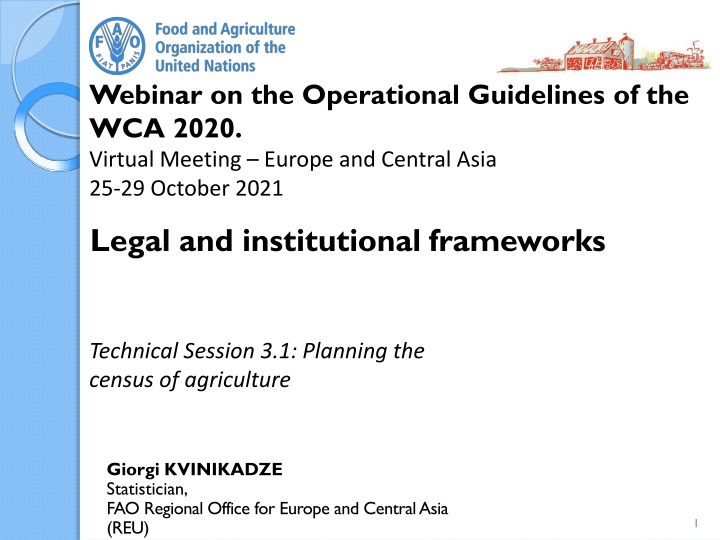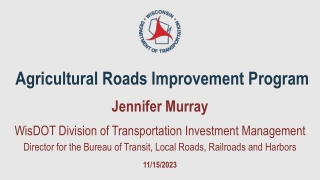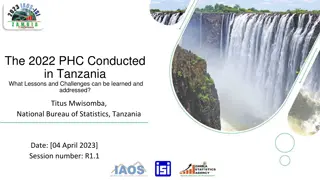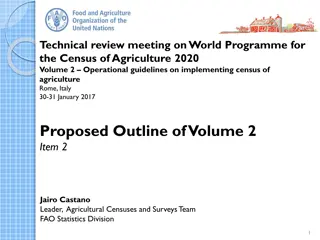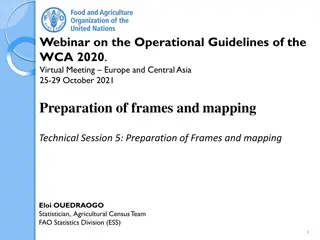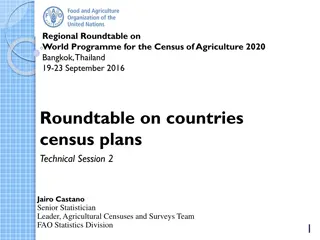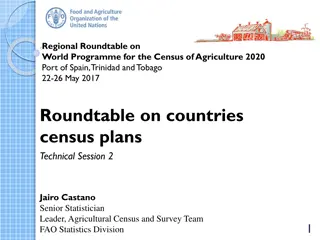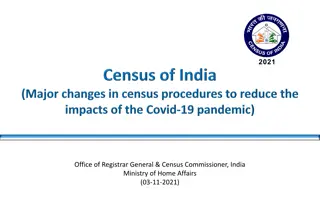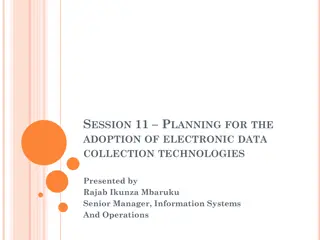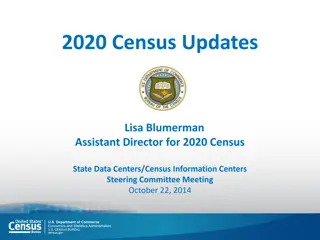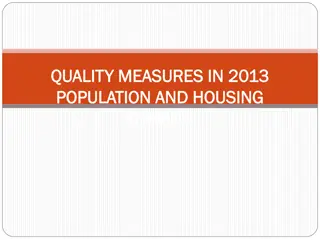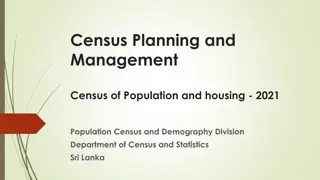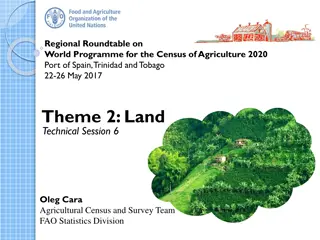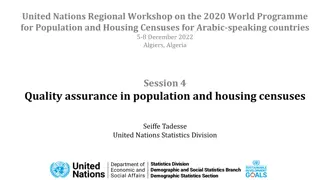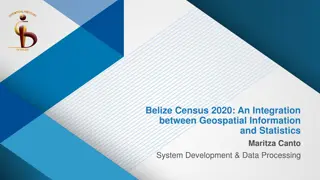Operational Guidelines for Agricultural Census Legislation
Legal and institutional frameworks essential for planning a census of agriculture, including census legislation within the national legal framework, political support, executing authority, and coordinating boards. Understand the key features of census legislation and its compliance with Fundamental Principles of Official Statistics.
Download Presentation

Please find below an Image/Link to download the presentation.
The content on the website is provided AS IS for your information and personal use only. It may not be sold, licensed, or shared on other websites without obtaining consent from the author.If you encounter any issues during the download, it is possible that the publisher has removed the file from their server.
You are allowed to download the files provided on this website for personal or commercial use, subject to the condition that they are used lawfully. All files are the property of their respective owners.
The content on the website is provided AS IS for your information and personal use only. It may not be sold, licensed, or shared on other websites without obtaining consent from the author.
E N D
Presentation Transcript
Webinar on the Operational Guidelines of the WCA 2020. Virtual Meeting Europe and Central Asia 25-29 October 2021 Legal and institutional frameworks Technical Session 3.1: Planning the census of agriculture Giorgi KVINIKADZE Statistician, FAO Regional Office for Europe and Central Asia (REU) 1
Contents CENSUS LEGISLATION WITHIN THE NATIONAL LEGAL FRAMEWORK MAIN FEATURES OF THE CENSUS LEGISLATION POLITICAL SUPPORT FOR CONDUCTING A CENSUS CENSUS EXECUTING AUTHORITY CENSUS COORDINATING BOARDS COUNTRY EXAMPLE 2
Contents CENSUS LEGISLATION WITHIN THE NATIONAL LEGAL FRAMEWORK MAIN FEATURES OF THE CENSUS LEGISLATION POLITICAL SUPPORT FOR CONDUCTING A CENSUS CENSUS EXECUTING AUTHORITY CENSUS COORDINATING BOARDS COUNTRY EXAMPLE 3
Census legislation within the national legal framework (1/2) The agricultural census (AC) legislation exists within overall national legal and administrative frameworks. It commonly consistsof: Basic or primary legislation (such as Act of Parliament ) enacted by a legislature or other governing body;and Secondary legislation (delegated, subordinate / subsidiary legislation), made by an executive authority (such as the Cabinet of Ministers, the Ministry of Agriculture, etc) under powers delegated by primary legislation. Census legal framework may be basedon: The primary legislation of general nature, such as statistics law or the law establishing the ministry of agriculture, for the ACs. Specific agricultural census laws; such a census law may prescribe the conduct of the census on a regular basis or may be set up before eachAC. The Law (Act) on Agricultural Statistics (e.g. in Germany, United Kingdom) or by the Law on Agriculture(Switzerland). 3
Census legislation within the national legal framework (1/2) General law or detailedlegislation: Both general laws and detailed census laws offer benefits anddrawbacks. The general features of a PrincipalAct: o to authorise census taking, o to designate the census executing authority (or censusagency ), o to state general provisions about the census implementationand o to empower a governmental institution, such as a ministry, to prescribe rules. Compliance of census legislation with Fundamental Principlesof Official Statistics(FPOS): A census of agriculture as a statistical operation for collecting, processing and disseminating data on the structure of agriculture, is an integral part of the national system of official statistics in a country. The census of agriculture should fully encompass the FPOS. 5
Contents CENSUS LEGISLATION WITHIN THE NATIONAL LEGAL FRAMEWORK MAIN FEATURES OF THE CENSUS LEGISLATION POLITICAL SUPPORT FOR CONDUCTING A CENSUS CENSUS EXECUTING AUTHORITY CENSUS COORDINATING BOARDS COUNTRY EXAMPLE 6
Main features of the census legislation Scope and coverage of the census Responsibility for the census Frequency of the census and time reference Administrative and financial provisions Rights and obligations of the public with respect to theAC Confidentiality of information Identification, obligations and rights of enumerators and other census personnel Access to administrative data sources (ADS) Census data dissemination Sanctions 7
Contents CENSUS LEGISLATION WITHIN THE NATIONAL LEGAL FRAMEWORK MAIN FEATURES OF THE CENSUS LEGISLATION POLITICAL SUPPORT FOR CONDUCTING A CENSUS CENSUS EXECUTING AUTHORITY CENSUS COORDINATING BOARDS COUNTRY EXAMPLE 8
Ensuring political support for conducting a census Like in a population census (PC), in an AC the combinationof three factors makes managing a censuschallenging: It is one of the largest statistical activities in acountry It is conducted only periodically, generally every 10years It involves the mobilization of important financial,human and other resources during a shortperiod. Strong political support and efficient coordinationbetween the census agency and other agencies isessential. 9
Contents CENSUS LEGISLATION WITHIN THE NATIONAL LEGAL FRAMEWORK MAIN FEATURES OF THE CENSUS LEGISLATION POLITICAL SUPPORT FOR CONDUCTING A CENSUS CENSUS EXECUTING AUTHORITY CENSUS COORDINATING BOARDS COUNTRY EXAMPLE 1 0
Census executing authority (1/2) The Census Agency (CA) should be specified in the primary census legislation. The administrative authority and responsibility to conduct ACs maybe: Delegated to a specific government institution, suchas: National Statistics Office(NSO) Ministry of Agriculture (MoA) or other executive branch of the government charged withagriculture Under the joined responsibility of NSO and MoA and possibly may involve other ministries governments. and agencies, and/or local 11
Census executing authority (2/2) The Census Office (CO): Has the primary and chief responsibility for planning, organizing, conducting and supervising theAC. Commonly is established within the CA on a permanent basis or just for period of preparation to thecensus. The number of census personnel is adjusted to meet the needs at different stages of censusoperation. The role of the Census Coordinator (usually the CO Head) is to ensure a successful censusprogramme. Often the CO consistsof: Central Office & Provincial Offices / District Offices (COs at sub nationallevel). 12
Contents CENSUS LEGISLATION WITHIN THE NATIONAL LEGAL FRAMEWORK MAIN FEATURES OF THE CENSUS LEGISLATION POLITICAL SUPPORT FOR CONDUCTING A CENSUS CENSUS EXECUTING AUTHORITY CENSUS COORDINATING BOARDS COUNTRY EXAMPLE 1 4
Census Coordinating boards (1/4) Technical Steering Committee (TSC): o Coordination of technical aspects of census preparation andimplementation. o Generally, responsible for the overall planning and direction of the census, subject to review by the census coordinator. o Endorses the AC work plan, scope and coverage, main methodological principles, questionnaires, manuals, budgetary and personnel requirements, plans for the publicity campaign, logistical needs, pre-test and pilot censuses, post-enumeration survey plan. o Consists of representatives of major stakeholders, who are able to provide high-level specialist advice and are in a position to take decisions on behalf of the institutions they represent. o Usually created by the regulatory text establishing the census. o The committee s chairperson could be the head of the CAor another person appointed by him/her. o Should start functioning at least two years ahead of the AC fieldwork and cease to function after the dissemination and archiving of census data. 15
Census Coordinating boards (2/4) National High-level Steering Committee (NSC): Main tasks: Facilitates good collaboration with relevant ministries / public agencies at the national and sub national levels, Ensures public support through a wide census publicity campaign. o It is chaired by a high-ranking official in the government and its members are high level representatives from ministries and other public agencies, as well as from NGOs, businesses and academia. o Useful especially in countries with little experience in AC taking, a de-centralized agricultural statistics system or/and lacking a well-established agricultural statistics. coordination mechanism of 16
Census Coordinating boards (3/4) Subcommittees, advisory and working groups: o May be created, under the area of coordination or supervision of amember of the TSC or NSC. o To advise on specific technical methodological aspects, questionnaire design, data processing, etc.), or on more general aspects (communications, transportation, logistics, recruitment, training, publicity, data dissemination, etc.). o Would normally consist of a small group of subject matter specialists. Advisory boards: matters (concepts and definitions, o To advise the CO on strategic issues or particular technical aspects of census operation. o Members could be experts on agriculture, agricultural statistics, sample design, IT, representatives of important users segments. o More relevant in the planning and preparation phases and not in the operational phases. 17
Census Coordinating boards (4/4) Provincial committees: o Main functions: to coordinate the activities of different institutions contributing to census implementation at the provincial level. o May be established especially in large countries. o Could make recommendations to the CA for items specific to the province to be included in census questionnaires and to advise on provincial tabulations. o Coordinated by the steering committee (TSC or NSC) and should be carried out in close cooperation with the provincial census office. o Usually the head of provincial census office act as a secretary of a provincial committee. o In some countries, census committees are also set up at district level and at a lower administrative level. 18
Contents CENSUS LEGISLATION WITHIN THE NATIONAL LEGAL FRAMEWORK MAIN FEATURES OF THE CENSUS LEGISLATION POLITICAL SUPPORT FOR CONDUCTING A CENSUS CENSUS EXECUTING AUTHORITY CENSUS COORDINATING BOARDS COUNTRY EXAMPLE 1 9
Country example: Legal framework Azerbaijan: 2015 Agricultural Census (1) The legal basis for conducting the AC 2015 in Azerbaijan consisted of: the Law on Official Statistics, of 18 February 1994, No. 789, with further amendments; Presidential Decree No. 2621 of 21 December 2012 on the approval of the State Programme on Development of Official Statistics in the Republic of Azerbaijan in 2013 2017; Resolution No. 357 of the Cabinet of Ministers dated 28 December 2013, specifying the conduct of the AC in 2015.
Country example: Legal framework Azerbaijan: 2015 Agricultural Census (2) The AC 2015 was conducted by the State Statistical Committee (SSC), which, together with its regional offices, was responsible for all activities related to preparation and implementation of the census, data processing and publication of census results. The Ministry of Agriculture, the Ministry of Economy, the Ministry of Ecology and Natural Resources, the Ministry of Finance, the State Committee on Property Issues, the Azerbaijan State Agrarian University, the Institute of Economy of National Sciences Academy and the Scientific-Research Institute on Agriculture Economy were involved in the elaboration of the census program.
THANKYOU! 22
